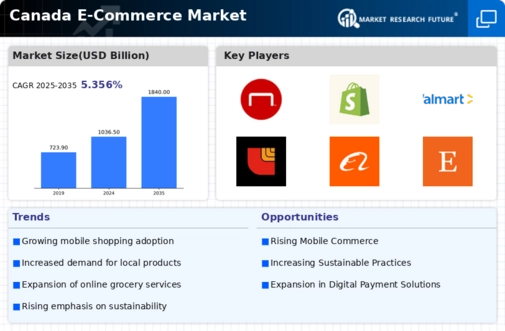The e commerce market in Canada is characterized by a dynamic competitive landscape, driven by rapid technological advancements and shifting consumer preferences. Major players such as Amazon (US), Shopify (CA), and Walmart (US) are at the forefront, each employing distinct strategies to enhance their market presence. Amazon (US) continues to innovate through its extensive logistics network and advanced AI capabilities, focusing on personalized shopping experiences. Shopify (CA), on the other hand, emphasizes empowering small and medium-sized enterprises (SMEs) with robust e commerce tools, thereby fostering a diverse marketplace. Walmart (US) leverages its vast physical store network to integrate online and offline shopping, enhancing customer convenience and operational efficiency. Collectively, these strategies contribute to a competitive environment that is increasingly focused on customer-centric solutions and technological integration.
Key business tactics within the market include localizing manufacturing and optimizing supply chains to enhance responsiveness to consumer demands. The competitive structure appears moderately fragmented, with a mix of established giants and emerging players. This fragmentation allows for a variety of business models, from direct-to-consumer approaches to marketplace platforms, each influencing the overall market dynamics. The collective influence of key players shapes a landscape where agility and innovation are paramount, as companies strive to differentiate themselves in a crowded marketplace.
In October 2025, Shopify (CA) announced a strategic partnership with a leading logistics provider to enhance its fulfillment capabilities. This move is significant as it aims to reduce delivery times for merchants using the platform, thereby improving customer satisfaction and retention. By streamlining logistics, Shopify (CA) positions itself as a more attractive option for SMEs looking to compete with larger players, potentially increasing its market share in the e commerce sector.
In September 2025, Amazon (US) launched a new initiative focused on sustainability, committing to achieve net-zero carbon emissions by 2040. This initiative is crucial as it aligns with growing consumer demand for environmentally responsible practices. By investing in renewable energy and sustainable packaging, Amazon (US) not only enhances its brand image but also addresses regulatory pressures, positioning itself as a leader in corporate responsibility within the e commerce market.
In August 2025, Walmart (US) expanded its online grocery delivery service, partnering with local farms to offer fresh produce directly to consumers. This strategic expansion reflects Walmart's commitment to integrating local sourcing into its supply chain, which may enhance its appeal to health-conscious consumers. By focusing on fresh and local products, Walmart (US) differentiates itself from competitors, potentially capturing a larger share of the grocery e commerce segment.
As of November 2025, current trends in the e commerce market include a pronounced shift towards digitalization, sustainability, and the integration of AI technologies. Strategic alliances are increasingly shaping the competitive landscape, enabling companies to leverage shared resources and expertise. Looking ahead, competitive differentiation is likely to evolve from traditional price-based competition to a focus on innovation, technology, and supply chain reliability. This shift suggests that companies that prioritize these elements may gain a competitive edge in an ever-evolving market.























Leave a Comment